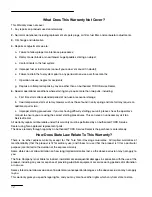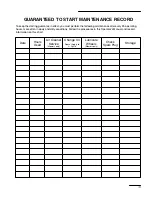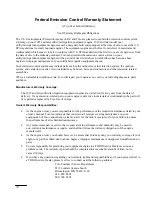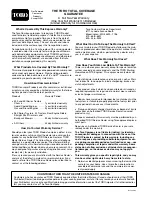
7
IMPORTANT: Excessive running of the
electric starter could damage the starter due
to overheating. To prevent possible damage,
do not run electric starter more than 10 times
at intervals of 5 seconds ON, 5 seconds OFF.
Then wait more than 40 minutes to allow
starter to cool before continuing to run
starter. Before repeating engine starting
procedure, check that ignition key switch is
ON, and make sure there is fresh fuel in fuel
tank. If engine continues to fail to start,
servicing may be needed.
5.
RECOIL STARTING—Hold snowthrower with
one hand and pull recoil starter vigorously with
other hand.
6.
When engine starts, push in choke slowly.
7.
TO ENGAGE ROTOR—Squeeze control bar to
handle. When the control bar handle is released,
the rotor blades stop, but the engine continues to
run.
8.
TO STOP ENGINE—Release control bar to stop
rotor, turn key to OFF, and wait for all moving
parts to stop before leaving operator’s position.
Operating Tips (Fig. 9)
1.
ADJUSTING DISCHARGE CHUTE —
Rotate chute crank clockwise to move discharge
chute to the right and counterclockwise to move
chute to the left. The chute deflector handle on
top of the discharge chute controls the height of
the snow stream. Do not overtighten the chute
deflector mounting nuts so excessive force is
required to adjust the deflector.
2.
SELF–PROPELLING ACTION — The
snowthrower clears down to the ground and
propels itself forward when the handle is raised
and the snowthrower is tilted slightly forward so
rotor blades strike the ground. The wheels do not
have to touch the ground in order to self-propel.
The further you tilt the handle forward, the faster
the snowthrower self-propels. However, depth
and height of snow affects forward speed.
Always overlap each swath and discharge
downwind whenever possible.
POTENTIAL HAZARD
•
When engine is running, discharge rotor is
turning.
WHAT CAN HAPPEN
•
Objects thrown from discharge chute can
cause personal injury.
HOW TO AVOID THE HAZARD
•
Keep yourself and other people away from
discharge opening when engine is running.
•
Before leaving operating position, stop
engine by turning key to OFF.
3.
Keep the area to be cleared free of stones, toys or
other foreign objects which may be picked up
and thrown by the rotor blades. Such items could
be covered by snowfall and, therefore, unnoticed
until struck by the rotor blades. Always be sure
to keep children and pets away from area of
operation.
4.
Should you find it necessary to clear snow from
crushed rock or gravel, push down on handle to
raise rotor blades clear of loose material that
could be thrown by the blades.
5.
In some snow and cold weather conditions, some
controls and moving parts may freeze solid.
Therefore, when any control becomes hard to
operate, stop the engine. Check all parts for
excessive freeze up. DO NOT USE
EXCESSIVE FORCE WHEN TRYING TO
OPERATE FROZEN CONTROLS. Free all
controls and moving parts before operating.
6.
AFTER CLEARING SNOW — Let engine run
for a few minutes so ice does not freeze moving
parts solid. After engine is shut off, wipe ice and
snow off entire unit. Operate chute crank several
times to clear mechanism of snow.
Summary of Contents for 38430
Page 8: ...vi 1 2 3 681 1 Thin layer 2 Thick layer 3 Wear indicator hole 20 ...
Page 25: ...17 ...
Page 26: ...18 ...
Page 27: ...19 ...














































